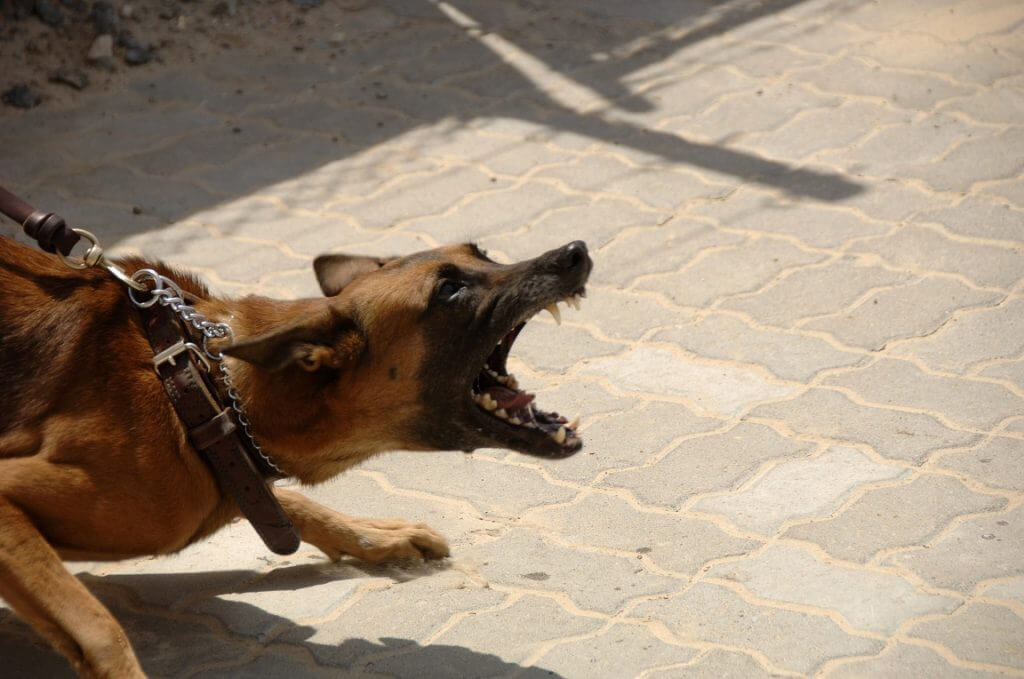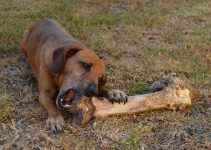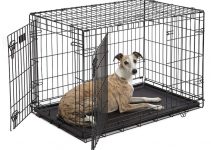This post may contain affiliate links. You can view our affiliate disclosure here.

Owning a dog can be a very enriching experience. They not only can lift your mood, but also offer you long-lasting companionship.
However, these social animals may at times become aggressive towards you, other dogs, kids, and even strangers.
When this happens, it often leaves many dog owners feeling frustrated, and at times, people may opt to take drastic measures such as returning their dogs to dog shelters.
Taking such measures is often unnecessary because there are many effective ways to calm an aggressive dog.
If your dog is exhibiting aggressive behaviours or you want to coexist with your dog safely, then this article has you covered.
We’ll discuss the questions that most dog owners ask: what is aggressive behaviour in a dog, how to calm an aggressive dog, and the signs you should look out for that indicate that your dog is about to become aggressive.
We’ll also walk you through causes of aggressive behaviour in dogs and the dos and don’ts during an aggression episode.
What is aggressive behaviour in a dog?
The term “aggression” is used to encompass all the behavioural characteristics a dog portrays when it’s about to attack someone or something.
Most of the time, a dog will display signs that it’s about to turn aggressive before it attacks. However, some dogs may rarely attack with little or no warning.
Understanding which signs point to an impending attack goes a long way in calming your dog during an aggression episode. Note some of the telltale signs that your dog is about to become aggressive:
- a rigid and tense body posture
- snarling, when a dog lifts its lip to bare teeth
- growling
- barking
- an averting gaze
- baring teeth
What are some of the causes of dog aggression?

Most dogs have a triggering factor that causes them to become confrontational. Below is a list of some of the causes of aggression among dogs, which will come in handy when trying to calm your dog:
- fear: when a dog feels threatened, it will retaliate by becoming aggressive.
- anxiety: when a dog experiences anxiety, it can become violent towards the causal factor.
- medical conditions like brain tumours and neurological ailments may cause your dog to become hostile.
- social aggression: this type of aggression occurs mainly in unsocialized dogs.
- possessiveness: dogs may exhibit aggressive behaviours when guarding things they value — for example, toys, bones, or their personal space.
The Dos & Don’ts During An Aggression Episode
DO:
- Reinforce calm behaviours with treats. Each time your dog becomes calm after a bout of aggression, give it treats.
- Remove what’s triggering your dog to become aggressive.
DON’T:
- Yell or shout at your dog. In most cases, this will only make the aggression worse.
- Turn your back on your dog or run. This will reinforce the aggression and give it the go-ahead to attack you or anyone around you.
- Walk towards your dog immediately when it starts exhibiting hostile behaviour. Instead, assume a harmless and relaxed posture which helps prevent your dog from getting defensive.
- Stare at your dog. Instead, avoid maintaining eye contact with it; this helps minimize an escalation of the aggression.
- Punish your dog due to aggressive behaviour. This can encourage it to repeat such behaviour to prove dominance.
How To Calm An Aggressive Dog

Knowing what triggers your dog to become aggressive is not the entire battle. You’ll also need to take action to calm it down during a violent confrontation or to prevent aggressive behaviour altogether.
Below are some of the most effective ways to bring your dog from an aggressive state to a calm state:
1. Stay calm and safe.
Dealing with an aggressive dog can give you a scare, especially if you are a novice dog owner or it’s the first time your dog is exhibiting such behaviour.
Many of us will want to scream or even run, but as we alluded to above, this will not help the situation; it will only make it worse.
By the same token, no matter how much you want to show your dog who is the boss, please don’t. Instead, keep calm and maintain your distance while trying to relieve the tension that’s causing your dog to act up.
You can do this by:
- assuming a less-threatening posture. Lower your gaze and relax your body.
- swiftly but cautiously removing what’s causing your dog to become aggressive.
- giving your dog simple commands like “sit” or “come” that will help it relax.
If your dog is on a leash, gently but firmly guide it away from the cause of aggression.
2. Prevent aggressive episodes in the first place.
If you can prevent the trigger, you can prevent the aggression entirely.
So, know what triggers your dog to act up and remove it. For example, if the trigger is unfamiliar people or animals, use dog cages or crates to keep your dog inside when you are expecting visitors.
Alternatively, you can use a dog leash to prevent unwanted attack episodes from occurring.
3. Desensitize.
Another way of calming down an aggressive dog is by desensitizing it from its triggers. Desensitization is the process that aims to diminish emotional responses to a negative stimulus after repeated exposure.
Remember not to overwhelm your dog during this process, as it may cause it to become even more aggressive than it previously was.
Consider employing the services of a professional and let them desensitize your dog, as the process can require a lot of time and effort. Going about it the wrong way may render it ineffective and difficult to reverse.
4. Socialize your dog.

Suppose you notice that your dog exhibits aggressive behaviour whenever it meets strangers or other dogs. In that case, it’s strongly recommended that your dog gets socialized and used to people and other dogs or animals around it.
You can do this by:
- arranging play dates for your dog with trained and social dogs.
- taking your dog to a dog park or for walks. If your dog has had a previous history of biting people or other animals, then use a muzzle to prevent a repeat of such incidents.
- enrolling your dog in socialization classes if possible.
Conclusion
Having a non-aggressive, friendly dog in your midst is one of the greatest things in the world. You can freely leave it around your kids without having to worry that an aggressive episode may ensue when you are not around.
At the end of the day, knowing what triggers your dog to become hostile and having it socialize with people and other dogs at a young age is of immense importance.
Desensitizing your dog to negative stimuli is also a viable approach. If your dog suddenly becomes hostile overnight, a visit to your vet may help you understand what the cause of the aggression is.
But suppose your hound is unresponsive to the strategies given in this article. If this is the case, or if you don’t have time to figure it out yourself, you may want to seek professional help.
But professional dog trainers can be extremely expensive at $150/hour or more. Most people can’t afford this cost, especially if it’s something that takes a lot of time to fix.
There’s a solution. At a very reasonable cost, you can get instant access to a dog training program by a certified dog trainer with over a decade of experience working with clients.
This trainer has figured out that dog aggression fundamentally come down to learning how to keep your dog calm and relaxed so that it can remain in control of its emotions.
This aggression training package is substantial, and it costs a tiny fraction of what you would pay for the services of a typical dog trainer or behaviorist.
You can alternatively read my review of this dog training program.
Thanks for reading this guide. Does your dog have aggression issues? What has been your experience? Feel free to share in the comment section below!



